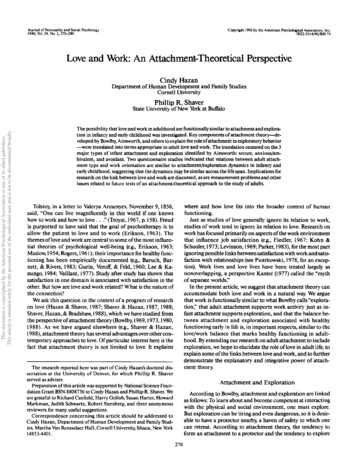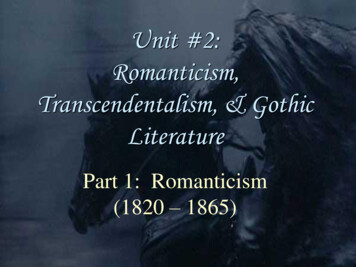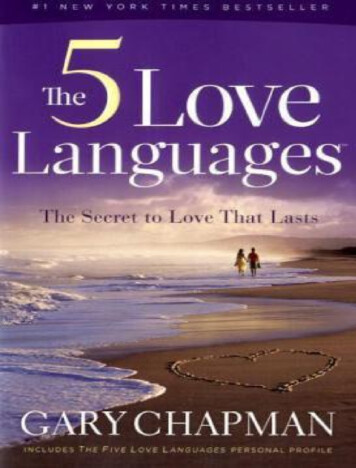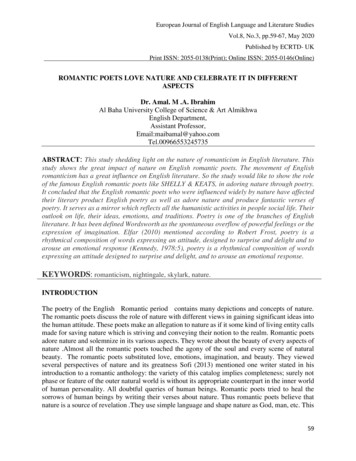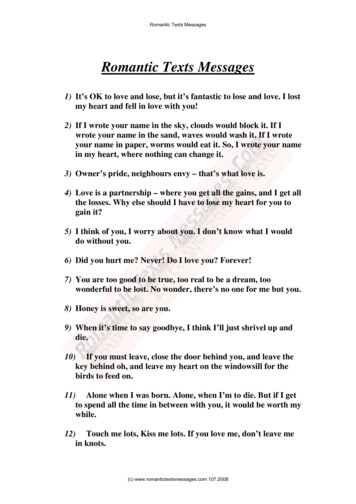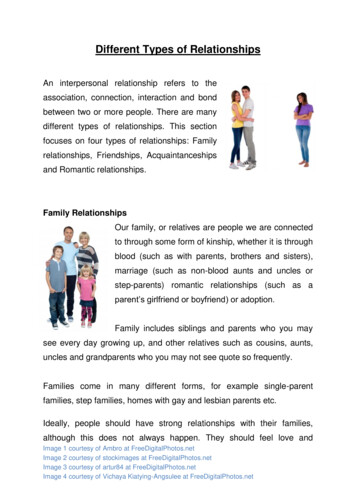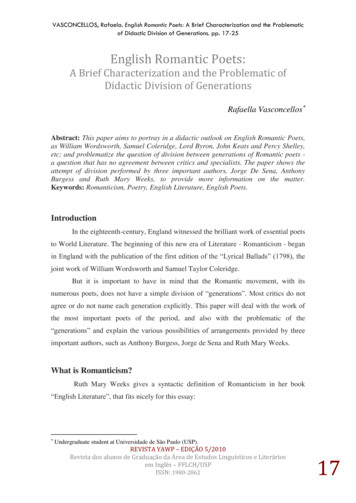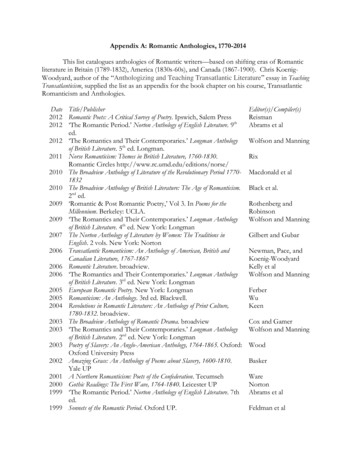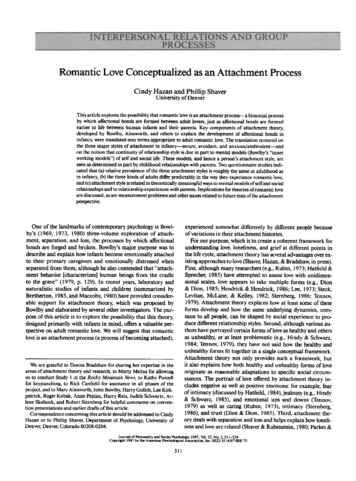
Transcription
Romantic Love Conceptualized as an Attachment ProcessCindy Hazan and Phillip ShaverUniversity of DenverThis article explores the possibilitythat romantic love is an attachment process--a biosocial processby which affectional bonds are formed between adult lovers, just as affectional bonds are formedearlier in life between human infants and their parents. Key components of attachment theory,developed by Bowlby, Ainsworth, and others to explain the development of affectional bonds ininfancy, were translated into terms appropriate to adult romantic love. The translation centered onthe three major styles of attachment in infancy--secure, avoidant, and anxious/ambivalent--andon the notion that continuity of relationship style is due in part to mental models (Bowlby's "innerworking models") of self and social life. These models, and hence a person's attachment style, areseen as determined in part by childhood relationships with parents. Two questionnaire studies indicated that (a) relative prevalence of the three attachment styles is roughly the same in adulthood asin infancy, (b) the three kinds of adults differ predictably in the way they experience romantic love,and (c) attachment style is related in theoreticallymeaningful waysto mental models of selfand socialrelationshipsand to relationship experiences with parents. Implicationsfor theories of romantic loveare discussed, as are measurement problems and other issues related to future tests of the attachmentperspective.One of the landmarks of contemporary psychology is Bowlby's (1969, 1973, 1980) three-volume exploration of attachment, separation, and loss, the processes by which affectionalbonds are forged and broken. Bowlby's major purpose was todescribe and explain how infants become emotionally attachedto their primary caregivers and emotionally distressed whenseparated from them, although he also contended that "attachment behavior [characterizes] human beings from the cradleto the grave" (1979, p. 129). In recent years, laboratory andnaturalistic studies of infants and children (summarized byBretherton, 1985, and Maccoby, 1980) have provided considerable support for attachment theory, which was proposed byBowlby and elaborated by several other investigators. The purpose of this article is to explore the possibility that this theory,designed primarily with infants in mind, offers a valuable perspective on adult romantic love. We will suggest that romanticlove is an attachment process (a process of becoming attached),experienced somewhat differently by different people becauseof variations in their attachment histories.For our purpose, which is to create a coherent framework forunderstanding love, loneliness, and grief at different points inthe life cycle, attachment theory has several advantages over existing approaches to love (Shaver, Hazan, & Bradshaw, in press).First, although many researchers (e.g., Rubin, 1973; Hatfield &Sprecher, 1985) have attempted to assess love with unidimensional scales, love appears to take multiple forms (e.g., Dion& Dion, 1985; Hendrick & Hendrick, 1986; Lee, 1973; Stock,Levitan, McLane, & Kelley, 1982; Sternberg, 1986; Tennov,1979). Attachment theory explains how at least some of theseforms develop and how the same underlying dynamics, common to all people, can be shaped by social experience to produce different relationship styles. Second, although various authors have portrayed certain forms of love as healthy and othersas unhealthy, or at least problematic (e.g., Hindy & Schwarz,1984; Tennov, 1979), they have not said how the healthy andunhealthy forms fit together in a single conceptual framework.Attachment theory not only provides such a framework, butit also explains how both healthy and unhealthy forms of loveoriginate as reasonable adaptations to specific social circumstances. The portrait of love offered by attachment theory includes negative as well as positive emotions: for example, fearof intimacy (discussed by Hatlield, 1984), jealousy (e.g., Hindy& Schwarz, 1985), and emotional ups and downs (Tennov,1979) as well as caring (Rubin, 1973), intimacy (Sternberg,1986), and trust (Dion & Dion, 1985). Third, attachment theory deals with separation and loss and helps explain how loneliness and love are related (Shaver & Rubenstein, 1980; Parkes &We are grateful to Donna Bradshaw for sharing her expertise in theareas of attachment theory and research, to Marry Meitus for allowingus to conduct Study 1 in the Rocky Mountain News, to Kathy Purcellfor keypunching, to Rick Canfield for assistance in all phases of theproject, and to Mary Ainsworth, John Bowlby,Harry Gollob, Lee Kirkpatrick, Roger Kobak, Anne Peplau, Harry Reis, Judith Schwartz, Arlene Skolnick, and Robert Sternberg for helpful comments on convention presentations and earlier drafts of this article.Correspondence concerning this article should be addressed to CindyHazan or to Phillip Shaver, Department of Psychology, University ofDenver, Denver, Colorado 80208-0204.Journal of Personality and Social Psychology, 1987, Vol. 52, No. 3, 511-524Colwfight 1987 by the American Psychological Association, Inc. 0022-3514/87/ 00.75511
512CINDY HAZAN AND PHILLIP SHAVERWeiss, 1983; Weiss, 1973). Finally, attachment theory linksadult love with socioemotional processes evident in childrenand nonhuman primates; it places love within an evolutionarycontext (Wilson, 1981). (See Sternberg & Barnes, in press, foran anthology of recent approaches to the study of adult love.)Attachment Theory and ResearchBowlby's attachment theory grew out of observations of thebehavior of infants and young children who were separatedfrom their primary caregiver (usually the mother) for variouslengths of time. Bowlby noticed what primate researchers hadalso observed in the laboratory and the field: When a humanor primate infant is separated from its mother, the infant goesthrough a predictable series of emotional reactions. The first isprotest, which involves crying, active searching, and resistanceto others' soothing efforts. The second is despair, which is a stateof passivity and obvious sadness. And the third, discussed onlywith reference to humans, is detachment, an active, seeminglydefensive disregard for and avoidance of the mother if she returns. Because of the remarkable similarities between humaninfants and other primate infants, Bowlby was led to considerthe evolutionary significance of infant--careglver attachmentand its maintenance in the face of separation.The attachment system, as Bowlby called the complex constellation of attachment feelings and behaviors, seems to haveevolved to protect infants from danger by keeping them closeto the mother. When very young, a human infant can do littlemore than cry, make eye contact, smile, and snuggle in to encourage its mother to keep it near. Once mobile, however, it canactively pursue its mother and vocalize to her. Bowlby and otherobservers of both human and primate behavior have noticedthat when an infant is healthy, alert, unafraid, and in the presence of its mother, it seems interested in exploring and mastering the environment and in establishing aifiliative contact withother family and community members. Researchers call this using the mother as a secure base.Attachment theory can be summarized in three propositions,phrased clearly in the second volume of Bowlby's trilogy:The first [proposition] is that when an individual is confident thatan attachment figure will be available to him whenever he desiresit, that person will be much less prone to either intense or chronicfear than will an individual who for any reason has no such confidence. The second proposition concerns the sensitive period duringwhich such confidence develops. It postulates that confidence inthe availability of attachment figures, or lack of it, is built up slowlyduring the years of immaturity--infancy, childhood, and adolescence-and that wliatever expectations are developed during thoseyears tend to persist relatively unchanged throughout the rest oflife. The third proposition concerns the role of actual experience.It postulates that the varied expectation'g of the accessibility andresponsiveness of attachment figures that individuals develop during the years of immaturity are tolerably accurate reflections ofthe experiences those individuals have actually had. (Bowlby, 1973,p. 235)The formation during early childhood of a smoothly functioning (i.e., secure) attachment relationship with a primarycaregiver, although the norm in our society, is by no meansguaranteed. Research by Ainsworth and others suggests that amother's sensitivity and responsiveness to her infant's signalsand needs during the first year of life are important prerequisites. Mothers who are slow or inconsistent in responding totheir infant's cries or who regularly intrude on or interfere withtheir infant's desired activities (sometimes to force affection onthe infant at a particular moment) produce infants who crymore than usual, explore less than usual (even in the mother'spresence), mingle attachment behaviors with overt expressionsof anger, and seem generally anxious. If, instead, the motherconsistently rebuffs or rejects the infant's attempts to establishphysical contact, the infant may learn to avoid her. On the basisof their observations, Ainsworth, Blehar, Waters, and Wall(1978) delineated three styles or types of attachment, oftencalled secure, anxious/ambivalent, and avoidant. Infants in theanxious/ambivalent category frequently exhibit the behaviorsBowlby called protest, and the avoidant infants frequently exhibit the behaviors he called detachment. A major goal of thisarticle is to apply this three-category system to the study of romantic love.In their description of the three attachment styles, Ainsworthet al. (1978) referred to infants' expectations concerning theirmothers' accessibility and responsiveness. This fits with Bowlby's claim that infants and children construct inner workingmodels of themselves and their major social-interaction partners. Because the expectations incorporated in these models aresome of the most important sources of continuity between earlyand later feelings and behaviors, they deserve special attention.According to Bowlby, working models (which we will also callmental models) and the behavior patterns influenced by themare central components of personality. The claim of cross-situational and cross-age continuity is still controversial but is supported by a growing list of longitudinal studies from infancythrough the early elementary school years (Dontas, Maratos,Fafoutis, & Karangelis, 1985; Erickson, Sroufe, & Egeland,1985; Main, Kaplan, & Cassidy, 1985; Sroufe, 1983; Waters,Wippman, & Sroufe, 1979). This evidence for continuity addsplausibility to the notion that a person's adult style of romanticattachment is also affected by attachment history.Continuity, according to Bowlby (1973), is due primarily tothe persistence of interrelated mental models of self and sociallife in the context of a fairly stable family setting:Confidence that an attachment figure is, apart from being accessible, likely to be responsive can be seen to turn on at least two variables: (a) whether or not the attachment figure is judged to be thesort of person who in general responds to calls for support and protection; [and] (b) whether or not the self is judged to be the sort ofperson towards whom anyone, and the attachment figure in particular, is likely to respond in a helpful way. Logically these variablesare independent. In practice they are apt to be confounded. As aresult, the model of the attachment figure and the model of theself are likely to develop so as to be complementary and mutuallyconfirming. (Bowlby, 1973, p. 238)Love as A t t a c h m e n tSo far, no one has'attempted to conceptualize the entire rangeof romantic love experiences in a way that parallels the typologydeveloped by Ainsworth and her colleagues. Nor has anyonewith an interest in romantic relationships pursued Bowlby'sidea that continuity in relationship style is a matter of mentalmodels of self and social life. Finally, no one has explored the
LOVE CONCEPTUALIZED AS AN ATTACHMENT PROCESS513possibility that the specific characteristics of parent-child relationships identified by Ainsworth et al. as the probable causesof differences in infant attachment styles are also among thedeterminants of adults' romantic attachment styles. These arethe major aims of this article.We derived the following hypotheses by applying Bowlby'sand Ainsworth's ideas and findings as literally as possible to thedomain of adult love.their mothers were generally cold and rejecting; and anxious/ambivalent respondents should remember a mixture of positiveand negative experiences with their mothers. As less researchhas been conducted with fathers, we tentatively expected thefindings related to them to be roughly similar to the findings formothers.Hypothesis 1Finally, because the attachment needs of insecure respondents are unlikely to be fully met, avoidant and anxious/ambivalent respondents should be especially vulnerable to loneliness.The avoidant types, however, may defend against or attempt tohide this vulnerable feeling and so report less loneliness thananxious/ambivalent respondents do.Given the descriptions of the secure, avoidant, and anxious/ambivalent styles, we expected roughly 60% of adults to classifythemselves as secure and the remainder to split fairly evenlybetween the two insecure types, with perhaps a few more in theavoidant than in the anxious/ambivalent category. In a summary of American studies of the three types of infants, Campos,Barrett, Lamb, Goldsmith, and Stenberg (1983) concluded that62% are secure, 23% are avoidant, and 15% are anxious/ambivalent. Given a diverse sample of American adults, we thought itreasonable to expect approximately the same proportions.Hypothesis 2Just as the feelings an infant presumably experiences in therelationship with his or her mother are thought to reflect thequality of attachment to her, we expected that different types ofrespondents--secure, avoidant, and anxious/ambivalent-would experience their most important love relationshipsdifferently. We predicted that the most important love experience of a secure adult would be characterized by trust, friendship, and positive emotions. For avoidant adults, love was expected to be marked by fear o f closeness and lack of trust. Anxious/ambivalent adults were expected to experience love as apreoccupying, almost painfully exciting struggle to merge withanother person. This last style is similar to what Hindy andSchwarz (1984) called anxious romantic attachment and Tennov (1979) called limerence.Hypothes 3Respondents' working models of self and relationships werealso expected to differ according to attachment style. Securetypes should believe in enduring love, generally find otherstrustworthy, and have confidence that the self is likable. Avoidant types should be more doubtful of the existence or durabilityof romantic love and believe that they do not need a love partnerin order to be happy. Anxious/ambivalent types should fall inlove frequently and easily but have difficulty finding true love.They should also have more self-doubts than the other two typesbecause, unlike avoidant respondents, they do not repress orattempt to hide feelings of insecurity.Hypothesis 4Because attachment style is thought to develop in infancy andchildhood, we expected respondents of the three types to reportdifferent attachment histories. According to the theory, securerespondents should remember their mothers as dependably responsive and caring; avoidant respondents should report thatHypothesis 5Study 1In an initial effort to test the attachment-theory approach toromantic love, we designed a "love quiz" to be printed in a localnewspaper. As explained by Shaver and Rubenstein (1983), thenewspaper questionnaire method has been used in a wide variety of studies, always with results that approximate those frommore expensive, more strictly representative surveys. The maindifference between newspaper survey respondents and participants in representative sample surveys is that the former haveslightly higher education levels. Also, depending on the topic,newspaper surveys tend to draw more female than male respondents. Neither of these biases seemed to preclude a valuable initial test of our ideas, and the gains in sample size and heterogeneity appeared to outweigh the cost of mild unrepresentativeness.A single-item measure of the three attachment styles was designed by translating Ainsworth et al?s (1978) descriptions ofinfants into terms appropriate to adult love. The love-experience questionnaire, which we will describe in detail, was basedon previous adult-love measures and extrapolations from theliterature on infant-caregiver attachment. The measure ofworking models was based on the assumption that consciousbeliefs about romantic love--concerning, for example, whetherit lasts forever and whether it is easy or difficult to find--arecolored by underlying, and perhaps not fully conscious, mentalmodels. The measure of attachment history was a simple adjective checklist used to describe childhood relationships with parents and the parents' relationship with each other.MethodSubjects. Analyses reported here are based on the first 620 of over1,200 replies received within a week following publication of the questionnaire. (The major findings were stable after the first few hundred,so additional replies were not keypunched.) Of these 620 replies, 205were from men and 415 were from women. The subjects ranged in agefrom 14 to 82, with a median age of 34 and a mean of 36. Averagehousehold income was 20,000 to 30,000; average education level was"some college" Just over half(51%)were Protestant, 22% were Catholic,3% were Jewish, 10% were atheist or agnostic, and 13% were "other."Ninety-one percent were "primarily heterosexual," 4% were "primarilyhomosexual," and 2% were "primarily bisexual" (3% chose not to answer). Forty-two percent were married at the time of the survey; 28%
514CINDY HAZAN AND PHILLIP SHAVERwere divorced or widowed, 9% were "living with a lover" and 31% weredating. (Some checked more than one category.)Measures and procedure. The questionnaire appeared in the July 26,1985, issue of the Rocky Mountain News on the first and second pagesof the Lifestyles section. Besides being highly visible there, it was referred to in a banner headline at the top of the paper's front page: "Tellus about the love of your life; experts ask 95 questions about your mostimportant romance" The instructions included the following sentences: "The questionnaire is designed to look at the most importantlove relationship you have ever had, why you got involved in it, and whyit turned out the way it did . . . . It may be a past or a current relationship, but choose only the most important one?' Given that there wasonly enough room to ask about one relationship, we decided to havesubjects focus on the one they considered most important.The questionnaire was divided into three parts. The first contained56 statements concerning the subject's most important relationship, forexample, "I (considered/consider)one of my best friends" and"I ( l o v e d / l o v e ) so much that I often (felt/feel)jealous?' (Theblank referred to the most important lover's name.) Responses wererecorded by circling SD, D, A, or SA to indicate points along a stronglydisagree to strongly agree continuum. The 56 statements, 4 each for 14a priori subscales, were adapted from previous love questionnaires(Dion & Dion, 1985; Hatfield & Sprecher, 1985; Hindy & Schwarz,1984; Lasswell & Lobsenz, 1980; Rubin, 1973; Steffen, McLaney, &Hustedt, 1984) or suggested by the literature on infant-caretaker attachment (e.g., Ainsworth et al., 1978).A principal-components analysis followed by equimax rotation wasperformed on the 56-item measure. Thirteen factors had eigenvaluesgreater than 1.0, and 12 corresponded to a priori scales. Items loadingabove .40 on 1 of the 12 predicted factors were analyzed for reliability,and items that reduced coefficient alpha were deleted. Table 1 providesthe names of the 12 scales and a sample item, the number of itemsretained, and coefficient alpha for each. Alpha ranged from .64 to .84with a mean of.76, which seemed adequate for preliminary tests of thehypotheses.Part 2 of the questionnaire asked whether the described relationshipwas current or past (61% were current, 39% were past), what the subject's relationship to that person was at the time of the survey, how longthe relationship had lasted, how many times the subject had been inlove, and whether he or she had experienced crushes before age 10. Thispart of the questionnaire also contained demographic questions Part 3 dealt with attachment style and attachment history. It includedsections dealing with the subject's childhood relationships with his orher mother and father and the parents' relationship with each other (thespecific items will be discussed more fully in the Results and Discussionsection). Also included were questions concerning how the subject typically felt in relationships (the exact wording appears in Table 2) andwhat he or she believed concerning the typical course of romantic love The questionnaire concluded with the open-ended question "Can youadd anything that might help us understand romantic love?" and a request for the subject's name and phone number if he or she was willingto be interviewed. (Over 60% of the subjects provided this information )Subjects were asked to mail their reply forms to the Rocky MountainNews within a week.Results a n d DiscussionFrequencies o f the three attachment styles. Hypothesis 1 concerned whether newspaper readers could meaningfully classifythemselves as avoidant, anxious/ambivalent, or secure in theirmost important r o m a n t i c relationship, given fairly simple descriptions o f the three attachment styles, and in particularwhether the frequencies o f the types would be similar to thosefound in studies o f infants and young children. Table 2 showsTable 1Information on Love-Experience ScalesScale nameHappinessFriendshipTrustFear of ivepreoccupationSample itemMy relationship with (made/makes) me veryhappy.I (considered/consider)one of my bestfriends.I (felt/feel) complete trust inI sometimes (felt/feel) thatgetting too close tocould mean trouble.I (was/am) well aware of' simperfections butit (did/does) not lessen mylove.I (felt/feel) almost as muchpain as joy in myrelationship with1 ( l o v e d / l o v e ) somuch that I often (felt/feel) jealous.Sometimes my thoughts(were/are) uncontrollablyNo. ofitemsa4.844.784.833.642 673.814.823.704.803.793.704.70onSexual attractionDesire for unionDesire forreciprocationLove at first sightI (was/am) very physicallyattracted toSometimes I (wished/wish)thatand I were asingle unit, a "we" withoutclear boundaries.More than anything, I(wanted/want) toreturn my feelings.Once I noticed ,I washooked.how the alternatives were worded and provides the percentageo f subjects endorsing each description.Just over half (56%) classified themselves as secure, whereasthe other half split fairly evenly between the avoidant and anxious/ambivalent categories (25% and 19%, respectively). Thesefigures are similar to proportions reported in American studieso f i n f a n t - m o t h e r attachment (Campos et al., 1983, summarized the proportions obtained in these studies as 62% secure,23% avoidant, and 15% anxious/ambivalent). O u r results suggest, but o f course do not prove, that subjects' choices amongthe alternatives were n o n r a n d o m and may have been determ i n e d by some o f the same kinds o f forces that affect the attachment styles o f infants and children. The remainder o f the resultsargue for the validity of subjects' self-classifications.Differences in love experiences. The second hypothesis predicted that subjects with different self-designated attachmentstyles would differ in the way they characterized their most important love relationship. Table 3 presents the m e a n subscalescores (each with a possible range o f I to 4) for each attachmenttype, along with the F ratio from a one-way analysis o f variance(ANOVA) on scores for each subscale.In line with the hypothesis, secure lovers described their most
LOVE CONCEPTUALIZED AS AN ATTACHMENT PROCESSTable 2Adult Attachment Types and Their Frequencies(Newspaper Sample)Question: Which of the followingbest describes your feelings?Answers and percentages."Secure (N 319, 56% ): I find it relativelyeasy to get close to othersand am comfortable depending on them and having them depend onme. I don't often worry about being abandoned or about someonegetting too close to me.Avoidant (N 145, 25% ): I am somewhat uncomfortable being closeto others; I find it difficult to trust them completely,difficultto allowmyself to depend on them. I am nervous when anyone gets too close,and often, love partners want me to be more intimate than I feelcomfortable being.Anxious/Ambivalent (N 110, 19% ): I find that others are reluctantto get as close as I would like. I often worry that my partner doesn'treally love me or won't want to stay with me. I want to mergecompletely with another person, and this desire sometimes scarespeople away.Note. Twenty-one subjects failed to answer this question, and 25checked more than one answer alternative.important love experience as especially happy, friendly, andtrusting. They emphasized being able to accept and supporttheir partner despite the partner's faults. Moreover, their relationships tended to endure longer: 10.02 years, on the average,compared with 4.86 years for the anxious/ambivalent subjectsand 5.97 years for the avoidant subjects,/7(2, 568) 15.89,p .001. This was the case even though members of all threegroups were 36 years old on the average. Only 6% of the securegroup had been divorced, compared with 10% of the anxious/ambivalent group and 12% of the avoidant group, F(2, 573) 3.36, p .05.The avoidant lovers were characterized by fear of intimacy,emotional highs and lows, and jealousy. They never producedthe highest mean on a positive love-experience dimension. Theanxious/ambivalent subjects experienced love as involving obsession, desire for reciprocation and union, emotional highsand lows, and extreme sexual attraction and jealousy. They provided a close fit to Tennov's (1979) description of limerence andHindy and Schwarz's (1984) conception of anxious romanticattachment, suggesting that the difference between what Tennovcalled love and limerence is the difference between secure andanxious/ambivalent attachment.Although the average love experiences of people in the threedifferent attachment categories differed significantly, for mostof the subscales all three types scored on the same side of themidpoint (2.50), emotional extremes and jealousy being theonly exceptions. Thus, there appears to be a core experienceof romantic love shared by all three types, with differences inemphasis and patterning between the types. The results alsosupport the ideas that love is a multidimensional phenomenonand that individuals differ in more ways than the intensity oftheir love experiences. Especially noteworthy was the fact thatthe ordering of means for the different attachment stylesdiffered for different dimensions. For the dimensions of happiness, friendship, trust, and fear of closeness, secure subjectsdiffered significantly from avoidant and anxious/ambivalent515subjects but these two insecure groups did not differ from eachother. On the dimensions of obsessive preoccupation, sexual attraction, desire for union, desire for reciprocation, and love atfirst sight, anxious/ambivalent subjects differed significantlyfrom avoidant and secure subjects, who did not differ from eachother. On the acceptance dimension, avoidant subjects (the leastaccepting) differed from anxious/ambivalent and secure subjects, and on emotional extremes and jealousy, all three groupswere statistically distinct. This variety of patterns supports theclaim that there are three different love styles, not simply threepoints along a love continuum.Differences in mental models. We attempted to assess whatBowlby (1969) called working models of relationships by usingthe items shown in Table 4. Each was either checked or notchecked as describing how the subject generally "view[s] thecourse of romantic love over t i m e " These dichotomous answerswere analyzed by attachment style, using a one-way ANOVA.(Because the answers were scored as either 0 or 1, the means canbe read as proportions.)In line with the third hypothesis, secure lovers said that romantic feelings wax and wane but at times reach the intensityexperienced at the start of the relationship and that in somerelationships romantic love never fades. The avoidant loverssaid the kind of head-over-heels romantic love depicted innovels and movies does not exist in real life, romantic love seldom lasts, and it is rare to find a person one can really fall inlove with. The anxious/ambivalent subjects claimed that it iseasy to fall in love and that they frequently feel themselves beginning to fall, although (like the avoidant subjects) they rarelyfind what they would call real love. Like the secure subjects,the anxious/ambivalentsubjects said they believe that romanticfeelings wax and wane over the course of a relationship.Differences in attachment history. Attachment history withparents was assessed in two ways. Subjects were asked whetherTable 3Love-Subscale Means for the Three AttachmentTypes (Newspaper Sample)Scale rustFear of closenessAcceptanceEmotional extremesJealousyObsessivepreoccupationSexual attractionDesire for unionDesire forreciprocationLov
love is an attachment process (a process of becoming attached), We are grateful to Donna Bradshaw for sharing her expertise in the areas of attachment theory and research, to Marry Meitus for allowing us to conduct Study 1 in the Rocky Mountain News, to Kathy Purcell for keypunching, to Rick Canfield for assistance in all phases of the .
